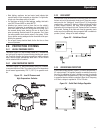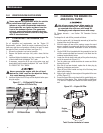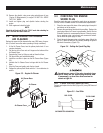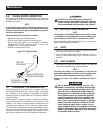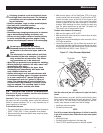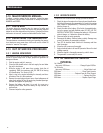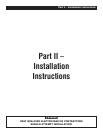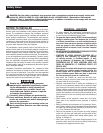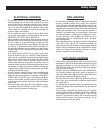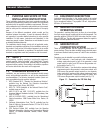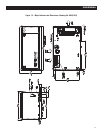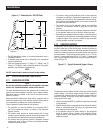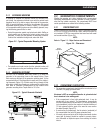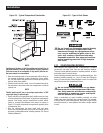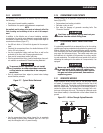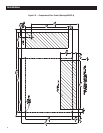
19
ELECTRICAL HAZARDS
The generator covered by this manual produces dangerous •
electrical voltages and can cause fatal electrical shock. Avoid
contact with bare wires, terminals, connections, etc., while the
unit is running. Ensure all appropriate covers, guards and bar-
riers are in place before operating the generator. If work must
be done around an operating unit, stand on an insulated, dry
surface to reduce shock hazard.
Do not handle any kind of electrical device while stand-•
ing in water, while barefoot, or while hands or feet are wet.
DANGEROUS ELECTRICAL SHOCK MAY RESULT.
During installation onto the vehicle, properly ground (bond) the •
generator either by solid mounting to the vehicle frame or chas-
sis, or by means of an approved bonding conductor. DO NOT
connect the bonding conductor to any generator part that might
be removed or disassembled during routine maintenance. If
the grounding conductor must be replaced, use only a flexible
conductor that is of No. 8 American Wire Gauge (AWG) copper
wire minimum.
If the vehicle electrical circuits can be powered by any other •
source of electricity (such as a “dockside” power receptacle),
there must be no possibility of connecting the different power
sources to the vehicle circuits at the same time. The dockside
(utility) power source must be positively isolated from the
vehicle circuits whenever the generator is operating. Failure to
isolate the vehicle circuits from the dockside power supply when
the generator is running may result in damage to the generator
or serious injury or death to dockside (utility) power workers due
to backfeed of electrical energy.
In case of accident caused by electric shock, immediately shut •
down the source of electrical power. If this is not possible,
attempt to free the victim from the live conductor. AVOID DIRECT
CONTACT WITH THE VICTIM. Use a nonconducting implement,
such as a rope or board, to free the victim from the live conduc-
tor. If the victim is unconscious, apply first aid and get immediate
medical help.
Never wear jewelry when working on this equipment. Jewelry •
can conduct electricity resulting in electric shock, or may get
caught in moving components causing injury.
FIRE HAZARDS
For fire safety, the generator must be installed and maintained •
properly. Installation always must comply with applicable
codes, standards, laws and regulations. Adhere strictly to local,
state and national electrical and building codes. Comply with
regulations the Occupational Safety and Health Administration
(OSHA) has established. Also, ensure that the generator is
installed in accordance with the manufacturer’s instructions
and recommendations. Following proper installation, do noth-
ing that might alter a safe installation and render the unit in
noncompliance with the aforementioned codes, standards,
laws and regulations.
Keep a fire extinguisher in the vehicle at all times. Extinguishers •
rated “ABC” by the National Fire Protection Association are
appropriate for use on the recreational vehicle generator electrical
system. Keep the extinguisher properly charged and be familiar
with its use. If there are any questions pertaining to fire extin-
guishers, consult the local fire department.
EXPLOSION HAZARDS
Do not smoke around the generator. Wipe up any fuel or oil spills •
immediately. Ensure that no combustible materials are left in the
generator compartment, or on or near the generator, as FIRE or
EXPLOSION may result. Keep the area surrounding the generator
clean and free from debris.
Gasoline is extremely FLAMMABLE and its vapors are EXPLOSIVE. •
Do not permit smoking, open flame, sparks or any source of
heat in the vicinity while handling gasoline. Comply with all laws
governing the storage and handling of gasoline.
Fuel lines must be properly installed and fastened, and free of •
leaks. There must be no possibility of gasoline vapors entering
the vehicle interior.
It is required that an approved, flexible, nonconductive fuel line •
between the generator fuel connection point and rigid fuel lines
be installed.
If the generator is equipped with a liquid propane (LP) gas fuel •
system, install the unit so it complies with all codes, standards
and regulations pertaining to such systems. LP gas is highly
explosive. The gas tends to settle in low areas where even the
slightest spark can ignite it and cause an explosion. Do not
allow gas vapors to enter the vehicle.
Safety Rules



